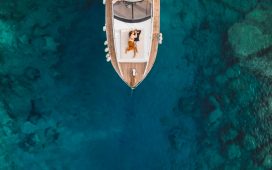Before I had children, my work as a research scientist meant frequent travel. I specialised in nature conservation and discovered that I was pregnant with my first child on a visit to an Ethiopian colleague’s field site in the Bale Mountains. The motherhood penalty in academia is high, and when my husband was offered a post in Shetland, I handed in my notice in the hope of finding a new job that would allow a better work-life balance.
We relocated north on the overnight ferry from Aberdeen, and despite a rough voyage and sea sickness, I was immediately smitten. Shetland is an archipelago of more than 100 islands, 16 of which are inhabited. Weather moves fast here and there is a constant play of light on a sea scattered with islands. I was excited to live in a place where there is always a chance of seeing a pod of orcas.
The first year of living in Shetland was marred by two miscarriages, but the next pregnancy held and my daughter was born. When the high cost of childcare locked me out of employment, I started to lose my sense of self. To keep my mind busy, I came up with a plan to walk Shetland’s coastline, all 1,679 rugged miles of it, section by section, when my husband could care for our children. I pored over maps and imagined walking along wild cliffs and finding hidden beaches. I couldn’t wait to get started.
But it was not to be. My body behaved strangely in the months after the birth. Pregnancy had triggered the onset of rheumatoid arthritis and damaged the joints between my pelvis and spine. Pain and fatigue made it difficult to care for my young children when my husband was at work. I became isolated, and depression set in.
It is strange to write this now, but I found my way forward by counting dead seabirds. Along with much marine litter, tides wash the bodies of stricken seabirds ashore. When my daughter was still a baby, I volunteered to monitor two beaches. I could park right next to each beach and walk slowly along the strandlines. My task was to count each bird, note the species and check its plumage for oil to collect data for a survey initiated in the late 1970s following the construction of Shetland’s oil and gas terminal.
My first survey was on a bitterly cold February day. The person training me paused to pluck a piece of plastic from the strandline. He handed it to me and explained that it was a lobster trap tag from Newfoundland or Labrador. I returned home with a pocket full of beach treasure and the feeling that a door had opened. I soon spent all of my spare time beachcombing, searching the shore for the strange and curious things that the tide leaves behind.
Beachcombing got me outside in all weathers and my mental health improved. I whiled away dark winter evenings researching the things I had found, some more natural than others. I began to share my “treasure” with a community of beachcombers online, from Shetland locals to people living on more distant shores. And thanks to the knowledge shared by fellow enthusiasts, I’d soon compiled my own wishlist of dream finds: messages in bottles, birch bark and beaver-gnawed wood from North America, rare eggcases (mermaid’s purses) and valuable ambergris from a sperm whale’s stomach.
Top of my list was a lucky sea bean, the drift seed of a tropical vine. I’d seen one in a local museum. It looked carved from brown wood and lightly polished – a plump and smooth-edged disc. A small notch interrupted its neat circumference, and I saw why they are sometimes called sea hearts. It was so light that I barely felt it in the palm of my hand. My thumbnail made no impression on its hard surface.
I bought a field guide to drift seeds and read that they have evolved to be buoyant and dispersed by water. Their tough and impermeable outer layer protects them as they float on the ocean’s surface. Some wash up on warm shores, where they can germinate, but others arrive in cold northern places like Shetland where they cannot naturally grow.
I’d assumed that sea beans were lucky finds because they are so rare. I’ve met local beachcombers who had never been lucky, others who have found more than one. But then I learned that they have been used as protective charms since the times of the Pagan Norse. They were said to keep women safe in childbirth and men safe from drowning. When I learned that a Shetland woman, Katherine Jonesdochter, was executed for witchcraft in 1616 and that her sea bean was used as evidence of her crime, I became even more obsessed with finding one of my own.
I’d lie awake at night in pain and imagine an island in the Caribbean with a giant seed pod hanging over a forest stream. I’d picture the pod splitting and a sea bean falling into the water and being carried to a river and out to sea. It was a comfort to think of a resilient sea bean drifting on the surface of the ocean.
after newsletter promotion
Beachcombing isn’t necessarily a form of escapism. Paying close attention to jetsam and flotsam means confronting much that is wrong with the world. Just as tracing Katherine Jonesdochter’s story deepened my understanding of misogyny, evidence of colonial racism can be found in the strandlines of Shetland too. My collection of lobster trap tags from North America exceeds 100, but only five were issued to Indigenous fishers. It is almost as if the ocean is showcasing white complacency, our slowness to connect the capitalist dots between forms of social oppression and environmental destruction.
I like to collect lobster trap tags but they are still litter, and each winter, storms heap staggering amounts of plastic on to the shores of these islands. Plastic also comes ashore hidden in the stomachs of dead fulmars – beautiful seabirds that nest on Shetland’s cliffs. I am glad of storms because they bring much ashore, but I fear for a future in which they become more frequent and more violent.
Our island life means we often have to travel to the Scottish mainland for medical treatment and, in some cases, to give birth. I can foresee a future in which we will once again seek comfort in protective charms.
It took me years of searching before I found a sea bean of my own. It lay among the pebbles, still wet from the tide and gleaming in a low winter sun. Euphoric moments like these are rare, but beachcombing is often absorbing enough to distract me from pain. Searching for sea glass one winter’s day, I failed to notice a pod of orcas swimming right by me, just a few metres offshore. It took the explosive exhalation of a whale to pull me out of my deeply meditative state.
Beachcombing has seen me through some challenging times and has taught me how to sustain hope. It has given me an unimagined intimacy with these astonishing islands and with the ways of the ocean. I have learned to travel the world without ever leaving home.











